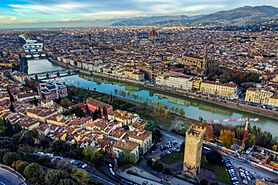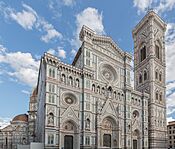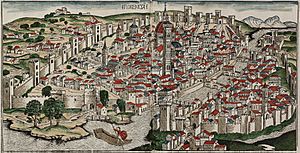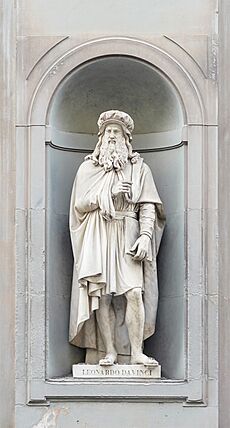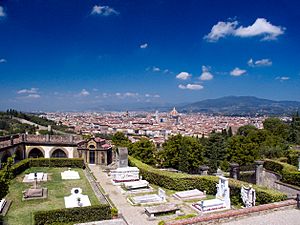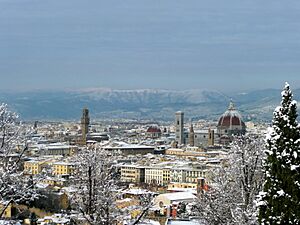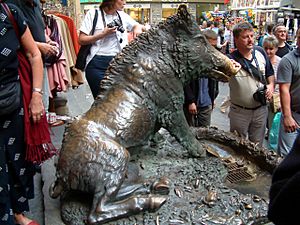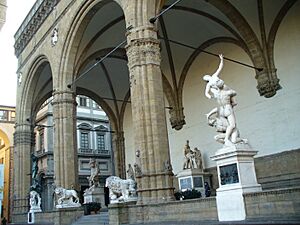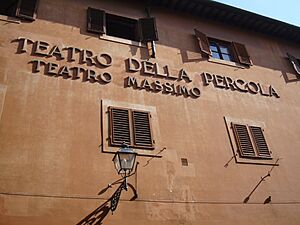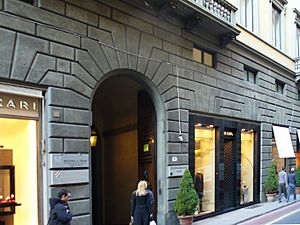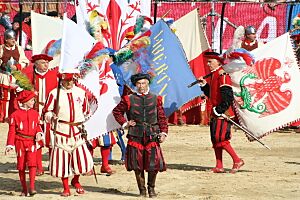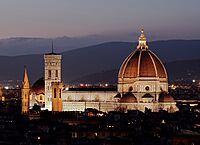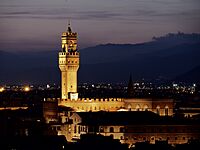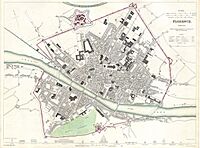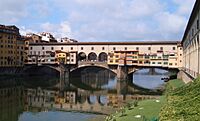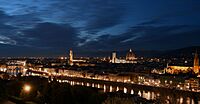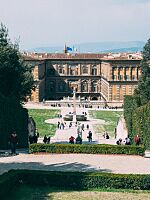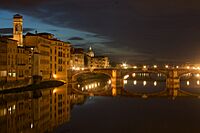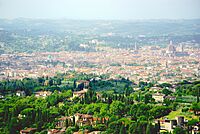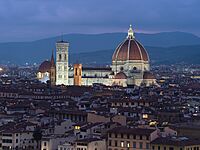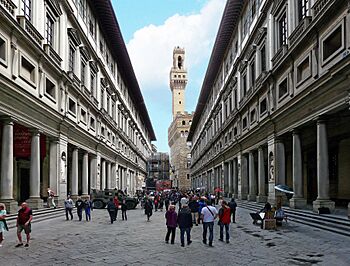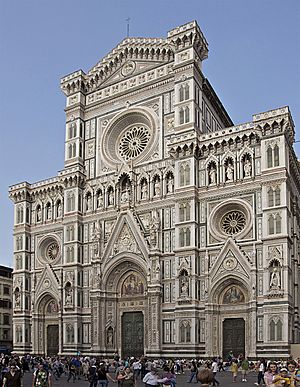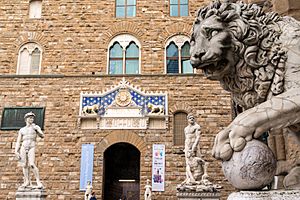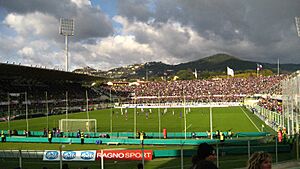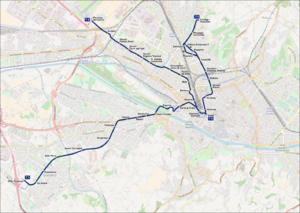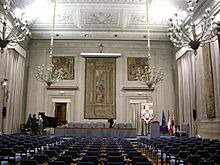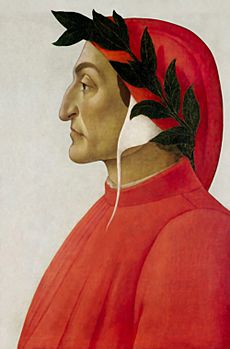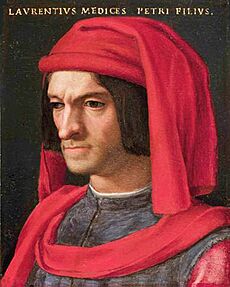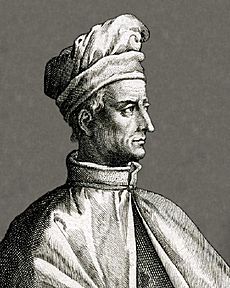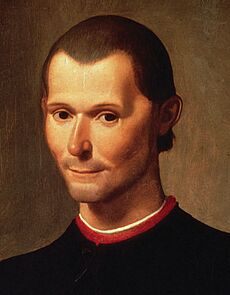Florence facts for kids
Quick facts for kids
Florence
Firenze (Italian)
|
|||
|---|---|---|---|
| Comune di Firenze | |||
|
Florence from Piazzale Michelangelo
Palazzo Vecchio
Ponte Vecchio
|
|||
|
|||
| Country | Italy | ||
| Region | Tuscany | ||
| Frazioni | Baronta, Callai, Galluzzo, Cascine del Riccio, Croce di Via, La lastra, Mantignano, Ugnano, Parigi, Piazza Calda, Pontignale, San Michele a Monteripaldi, Settignano | ||
| Area | |||
| • Total | 102.32 km2 (39.51 sq mi) | ||
| Elevation | 50 m (160 ft) | ||
| Population
(1 January 2022)
|
|||
| • Total | 367,150 | ||
| • Density | 3,588.25/km2 (9,293.5/sq mi) | ||
| Time zone | UTC+1 (CET) | ||
| • Summer (DST) | UTC+2 (CEST) | ||
| Postal code |
50121–50145
|
||
| Dialing code | 055 | ||
| Patron saint | John the Baptist | ||
| Saint day | 24 June | ||
Florence (pronounced FLORR-ənss) is a famous city in Italy. It is the capital of the Tuscany region. It's the biggest city in Tuscany, with over 360,000 people living there.
Long ago, Florence was a major center for trade and money in Europe. Many people believe it was the birthplace of the Renaissance. This was a time when art, culture, and new ideas really bloomed. Florence became super important in Italy and beyond during this period. The city had a lively history, including times when the powerful Medici family ruled. From 1865 to 1871, Florence was even the capital of the Kingdom of Italy. The way people spoke in Florence became the basis for the standard Italian we know today. This was thanks to famous writers like Dante Alighieri and Petrarch.
Today, millions of tourists visit Florence every year. UNESCO named its historic center a World Heritage Site in 1982. The city is famous for its amazing Renaissance art, beautiful buildings, and many museums. Two of the most famous are the Uffizi Gallery and the Palazzo Pitti. Florence is also a big name in Italian fashion. Forbes magazine even called it one of the most beautiful cities in the world in 2010!
Contents
What's in a Name?
The Italian name for Florence is Firenze. This name comes from the Latin word Florentia. It means "to blossom" or "to flourish," which sounds just right for a city so full of life and art!
A Journey Through Time
Florence started as a Roman city way back in 59 BC. Later, it became a busy trading and banking city. It was the birthplace of the Italian Renaissance. From the 1300s to the 1500s, Florence was one of the most important cities in Europe for politics, money, and culture.
The language spoken in Florence in the 1300s became the model for the Italian language. This was mostly because of famous writers from Tuscany like Dante, Petrarch, and Giovanni Boccaccio. Their amazing works helped the Florentine way of speaking become the main literary language for all of Italy.
During the late Middle Ages, Florentine money, especially the gold coin called the florin, helped industries grow all over Europe. Florentine bankers even helped fund the English kings during the Hundred Years' War. They also helped the Pope rebuild Rome during the Renaissance.
Florence was home to the Medici family, one of the most important noble families in European history. Lorenzo de' Medici was a brilliant leader and supporter of the arts in the late 1400s. Two Medici family members even became popes! Catherine de' Medici and Marie de' Medici both became queens in France. The Medici family ruled Florence as Grand Dukes of Tuscany from 1569 until 1737.
In 1865, Florence became the capital of the new Kingdom of Italy. But just six years later, in 1871, the capital moved to Rome.
Roman Beginnings
The Romans founded Florence in 59 BC. It was built like an army camp for retired soldiers. Its location on the Via Cassia, a main road, and in the fertile Arno valley, quickly made it an important trading spot.
Early Middle Ages
After the Romans, Florence went through tough times with different rulers. Its population dropped a lot. Peace returned under the Lombards in the 6th century. Later, Charlemagne conquered it in 774. Florence then became part of the March of Tuscany. The city started to grow again, and trade became strong.
A City-State Rises
Around 1000 AD, Florence became a "commune," which means it was a self-governing city-state. The Arno river was key to its success. It provided power for industries, especially textiles, and a way to reach the Mediterranean Sea for international trade. Florentine bankers were very skilled and introduced new financial ideas like bills of exchange. This helped Florence become very rich and powerful.
The Renaissance and the Medici
Around 1325, Florence had about 120,000 people in the city. But the terrible Black Death in 1348 cut the population by more than half.
In the 1400s, Florence was one of Europe's largest and wealthiest cities. Cosimo de' Medici was the first Medici to secretly control the city. He was a banker to the pope, which gave his family huge power. Cosimo's grandson, Lorenzo, became known as "Lorenzo the Magnificent." He was a great supporter of the arts, helping artists like Michelangelo, Leonardo da Vinci, and Sandro Botticelli.
After Lorenzo's death in 1492, his son Piero II took over. But when the French king Charles VIII invaded Italy, Piero II made a deal that angered the Florentines. They kicked him out in 1494, and Florence became a republic again.
Savonarola and Machiavelli

During this time, a monk named Girolamo Savonarola became very powerful. He preached against luxury and corruption. He even criticized Pope Alexander VI. Because of this, he was banned from speaking and later kicked out of the church. The Florentines eventually turned against him, arrested him, and executed him in 1498.
Another important Florentine was Niccolò Machiavelli. He was a political thinker famous for his book The Prince. This book gives advice on how rulers should govern. Machiavelli also wrote the Florentine Histories, a history of the city.
In 1512, the Medici family returned to power with help from Spanish and Papal troops. Two Medici cousins, Giovanni and Giulio, both became Popes! They were also big supporters of art. But in 1527, Florentines kicked out the Medici again. However, the Medici came back for good in 1530.
Florence officially became a monarchy in 1531. Alessandro de' Medici became the first Duke. The Medici family ruled for over 200 years.
18th and 19th Centuries

When the Medici family line ended in 1737, Florence became part of the Austrian Empire for a while. Later, Napoleon took control, and Florence was part of France. After Napoleon's fall, the Austrian rulers returned.
In 1861, Italy became a united country. Florence became Italy's capital in 1865. To modernize the city, old markets and medieval houses were torn down. New streets and buildings were put in their place. The main square, now called Piazza della Repubblica, was made much wider. But just six years later, in 1871, Rome became the capital of Italy.
20th Century
During World War II, German forces occupied Florence from 1943 to 1944. On July 3, 1944, Hitler declared it an "open city" to protect its art. But in early August, as German troops left, they destroyed all the bridges over the Arno river except for the Ponte Vecchio. This made it hard for Allied troops to cross.
Florence was freed by New Zealand, South African, and British soldiers on August 4, 1944. Many Allied soldiers who died fighting in Tuscany are buried in cemeteries outside the city.
In November 1966, the Arno river flooded parts of the city center. This damaged many precious art treasures. You can still see small signs on walls around the city showing how high the floodwaters reached.
Where is Florence?
Florence sits in a valley surrounded by hills like Careggi, Fiesole, and Settignano. The Arno river flows through the city, along with a few smaller rivers.
Weather in Florence
Florence has hot summers with some rain and cool, damp winters. Because there isn't a strong wind, summer temperatures can be higher than along the coast. Snow is rare. The hottest temperature ever recorded was 42.6°C (108.7°F) in July 1983. The coldest was -23.2°C (-9.8°F) in January 1985.
| Climate data for Florence (Florence Airport) (1991–2020) | |||||||||||||
|---|---|---|---|---|---|---|---|---|---|---|---|---|---|
| Month | Jan | Feb | Mar | Apr | May | Jun | Jul | Aug | Sep | Oct | Nov | Dec | Year |
| Record high °C (°F) | 21.6 (70.9) |
23.4 (74.1) |
28.5 (83.3) |
28.7 (83.7) |
33.8 (92.8) |
41.8 (107.2) |
42.6 (108.7) |
39.5 (103.1) |
36.4 (97.5) |
30.8 (87.4) |
25.2 (77.4) |
20.4 (68.7) |
42.6 (108.7) |
| Mean daily maximum °C (°F) | 11.2 (52.2) |
12.7 (54.9) |
16.2 (61.2) |
20.0 (68.0) |
24.3 (75.7) |
29.1 (84.4) |
32.3 (90.1) |
32.4 (90.3) |
27.3 (81.1) |
21.5 (70.7) |
15.6 (60.1) |
11.4 (52.5) |
21.2 (70.1) |
| Daily mean °C (°F) | 6.6 (43.9) |
7.6 (45.7) |
10.7 (51.3) |
14.0 (57.2) |
18.3 (64.9) |
22.6 (72.7) |
25.4 (77.7) |
25.4 (77.7) |
20.9 (69.6) |
16.1 (61.0) |
11.1 (52.0) |
7.0 (44.6) |
15.5 (59.9) |
| Mean daily minimum °C (°F) | 2.1 (35.8) |
2.5 (36.5) |
5.1 (41.2) |
8.1 (46.6) |
11.9 (53.4) |
16.0 (60.8) |
18.4 (65.1) |
18.5 (65.3) |
15.0 (59.0) |
10.9 (51.6) |
6.4 (43.5) |
2.6 (36.7) |
9.8 (49.6) |
| Record low °C (°F) | −23.2 (−9.8) |
−9.9 (14.2) |
−8.0 (17.6) |
−2.2 (28.0) |
3.6 (38.5) |
5.6 (42.1) |
10.2 (50.4) |
9.6 (49.3) |
3.6 (38.5) |
−1.4 (29.5) |
−6.0 (21.2) |
−8.6 (16.5) |
−23.2 (−9.8) |
| Average precipitation mm (inches) | 58.1 (2.29) |
63.8 (2.51) |
61.4 (2.42) |
67.2 (2.65) |
63.0 (2.48) |
44.8 (1.76) |
24.6 (0.97) |
36.5 (1.44) |
66.8 (2.63) |
105.1 (4.14) |
115.3 (4.54) |
81.4 (3.20) |
788 (31.03) |
| Average precipitation days (≥ 1.0 mm) | 7.5 | 7.2 | 7.0 | 8.7 | 7.6 | 5.2 | 2.9 | 4.0 | 6.2 | 8.8 | 10.0 | 9.6 | 84.7 |
| Average relative humidity (%) | 71.5 | 67.3 | 64.6 | 64.7 | 64.9 | 62.9 | 60.6 | 60.5 | 64.4 | 70.5 | 74.6 | 74.1 | 66.7 |
| Mean daily sunshine hours | 3.0 | 4.0 | 5.0 | 6.0 | 8.0 | 9.0 | 10.0 | 9.0 | 7.0 | 5.0 | 3.0 | 3.0 | 6.0 |
| Percent possible sunshine | 33 | 40 | 42 | 46 | 53 | 60 | 67 | 64 | 58 | 45 | 30 | 33 | 48 |
| Source 1: NOAA | |||||||||||||
| Source 2: Servizio Meteorologico Weather Atlas | |||||||||||||
| Climate data for Florence | |||||||||||||
|---|---|---|---|---|---|---|---|---|---|---|---|---|---|
| Month | Jan | Feb | Mar | Apr | May | Jun | Jul | Aug | Sep | Oct | Nov | Dec | Year |
| Mean daily daylight hours | 9.0 | 10.0 | 12.0 | 13.0 | 15.0 | 15.0 | 15.0 | 14.0 | 12.0 | 11.0 | 10.0 | 9.0 | 12.1 |
| Average Ultraviolet index | 1 | 2 | 4 | 5 | 7 | 8 | 8 | 7 | 5 | 3 | 2 | 1 | 4.4 |
| Source: Weather Atlas | |||||||||||||
People of Florence
Florence is home to about 370,000 people. Most residents are Italian. However, Florence is also a diverse city with people from many other countries. Large groups come from Romania, China, Peru, Albania, and the Philippines.
Most people in Florence are Roman Catholic. There is also a notable Muslim community and a historic Jewish community with a beautiful synagogue.
Foreign-born population (31.12.2019)
| # | Country | Population |
|---|---|---|
| 1 | 8,461 | |
| 2 | 6,409 | |
| 3 | 5,910 | |
| 4 | 5,108 | |
| 5 | 4,939 | |
| 6 | 2,541 | |
| 7 | 1,942 | |
| 8 | 1,801 | |
| 9 | 1,418 | |
| 10 | 1,175 | |
| 11 | 1,137 | |
| 12 | 1,037 | |
| 13 | 965 |
Florence's Economy
Tourism is the biggest industry in Florence. Millions of visitors and students come each year, bringing lots of money to the city. In 2015, tourism brought in about €2.5 billion! Condé Nast Traveler magazine even called Florence the second-best city in the world in 2013.
What Florence Makes
Florence is also a major center for making and selling goods. Factories in the suburbs produce furniture, rubber, chemicals, and food. The city is famous for its traditional products like antiques, leather goods, jewelry, and art copies. High fashion clothes are also a big part of Florence's economy.
The city also earns money from services, cultural events, and fashion shows. Heavy industry and machinery are important too. Florentine businesses are known for making high-quality goods.
All About Tourism
Tourism is super important in central Florence. From April to October, there are more tourists than local people! Tickets to famous places like the Uffizi and Accademia galleries often sell out. Many tourists also visit the beautiful churches like Santa Croce and Santa Maria Novella.
Florence is thought to have the most art per square mile in the world. So, cultural tourism is very strong. The Uffizi museum alone sold over 1.9 million tickets in 2014!
While tourism brings money, it also brings challenges. Popular spots can get very crowded. The mayor of Florence has even taken steps to encourage tourists to be respectful of the city's heritage. For example, he had church steps sprayed with water to stop people from picnicking there. He also wants restaurants to use traditional Tuscan products.
Delicious Food and Wine
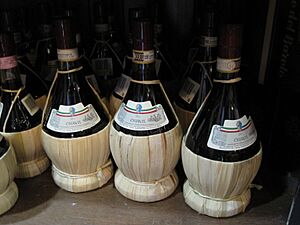
Food and wine have always been important to Florence's economy. The Chianti region, famous for its wines, is just south of the city. The local Sangiovese grapes are used in many delicious wines.
Florentine food comes from a tradition of simple, hearty meals. Many dishes use meat. You might find trippa (tripe) and lampredotto (stomach) sold at food carts. Popular appetizers include crostini toscani, which are bread slices with a chicken liver spread.
Tuscan bread, which is usually saltless, is often used in soups like ribollita and pappa al pomodoro. In summer, you can enjoy panzanella, a salad made with bread and fresh vegetables. A must-try is the bistecca alla fiorentina, a large T-bone steak cooked over hot charcoal and served very rare. Most dishes are served with local olive oil, which is also world-famous. For dessert, try schiacciata alla fiorentina, a soft, flatbread cake popular during Carnival.
Culture and Art
Amazing Art
Florence was the birthplace of High Renaissance art, which lasted from about 1500 to 1527. Renaissance art focused on making things look natural and showing human feelings. Unlike older art, which was often very symbolic, Renaissance art was more realistic and individual. Artists like Donatello, Michelangelo, and Raphael started signing their works. Religion was still important, but religious figures in art began to look more human. This new age brought a rebirth of ideas from ancient Greece and Rome.
Many famous artists lived in Florence. These include Cimabue and Giotto, who are considered the fathers of Italian painting. Also, Arnolfo di Cambio and Andrea Pisano changed architecture and sculpture. Filippo Brunelleschi, Donatello, and Masaccio were pioneers of the Renaissance. And of course, the amazing Leonardo da Vinci and Michelangelo!
You can see their works in Florence's many museums. The Uffizi Gallery has paintings from the "Golden Ages." The Bargello has Renaissance sculptures. The Galleria dell'Accademia is home to Michelangelo's famous David statue. The Palazzo Pitti has a huge collection of art from the Medici family.
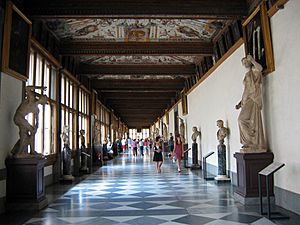
Florentine architects like Filippo Brunelleschi and Leon Battista Alberti were key to Renaissance architecture. The cathedral, with Brunelleschi's huge dome, dominates the city's skyline. This dome, built in the 14th century, was the largest of its kind at the time. It's still the largest brick dome in the world! Right in front of it is the old Baptistery. Many original artworks from these buildings are now kept safely in the Museo dell'Opera del Duomo.
Florence has many beautiful churches filled with art, such as San Miniato al Monte, San Lorenzo, Santa Maria Novella, and Santa Croce.
Language of Florence
The language spoken in Florence, called fiorentino, is a Tuscan dialect. It's actually the direct ancestor of modern Italian! While it's very similar to standard Italian, there are some small differences in words and how they are said.
Famous writers like Dante, Petrarch, and Boccaccio chose to write in their local Florentine language instead of Latin. This helped make Florentine the main literary language of Italy.
Music and Opera
Florence has been a center for music since the Middle Ages. In the late 1500s, a group called the Florentine Camerata started experimenting with putting Greek myths to music and performing them. This was the beginning of opera! Opera then spread from Florence across Italy and Europe.
The piano was also invented in Florence in 1709 by Bartolomeo Cristofori. Many composers and musicians have lived in Florence, contributing to its rich musical history.
Florence in Movies and Games
Florence has been the setting for many movies and books. Some famous films include Hannibal and A Room with a View. The city has also appeared in video games like Assassin's Creed II.
Fashion Capital
Florence has been a textile production center since the 1300s. Many people consider it the birthplace of the modern Italian fashion industry after World War II. Famous Italian fashion houses like Salvatore Ferragamo, Gucci, Roberto Cavalli, and Emilio Pucci are based in Florence. You can find luxury boutiques from brands like Armani and Bulgari on Florence's fancy shopping streets, like Via de' Tornabuoni.
Special Traditions
Scoppio del Carro
The Scoppio del Carro means "Explosion of the Cart." It's a special celebration on Easter Sunday. A big cart, pulled by white oxen, is brought to the Piazza del Duomo. A rope connects the cart to the inside of the cathedral. At the end of the Easter mass, a model dove flies out from the church and lights fireworks on the cart! This is believed to bring good luck to the city.
Calcio Storico
Calcio Storico Fiorentino means "Historic Florentine Football." It's a traditional sport that's a bit like a mix of soccer and rugby. It started in the Middle Ages, when nobles played it in colorful costumes. A famous match was played in 1530 during the siege of Florence. Even though the city was under attack, the Florentines played the game to show they weren't afraid!
Today, the game is played in the Piazza di Santa Croce. A temporary arena is built with sand and bleachers. Four teams, representing different parts of Florence, play matches in late June and early July. The teams are Azzurri (light blue), Bianchi (white), Rossi (red), and Verdi (green).
Famous Places to See
Florence is often called the "cradle of the Renaissance" because of its amazing buildings, churches, and monuments. The most famous is the Cathedral of Santa Maria del Fiore, known as The Duomo. Its huge dome was built by Filippo Brunelleschi. The nearby Campanile (bell tower) and the Baptistery are also must-sees. The historic center of Florence was named a World Heritage Site by UNESCO in 1982.
The city's design still shows its Roman origins, but most of Florence was built during the Renaissance. The Palazzo Vecchio (Old Palace) and the Duomo dominate the skyline.
The Arno river is a big part of Florence's history. Locals have had a complicated relationship with it, as it brought both trade and devastating floods.
One bridge stands out: the Ponte Vecchio ('Old Bridge'). It's famous for the many shops built right on its edges. This bridge also has a secret passage called the Vasari Corridor, which connects the Uffizi Gallery to the Medici family's palace. The current bridge was rebuilt in the 1300s and was the only bridge in Florence to survive World War II.
The church of San Lorenzo holds the Medici Chapels. These are the burial places of the powerful Medici family.
The Uffizi Gallery is one of the best art museums in the world. It was started with a huge gift from the last Medici family member. It's located in the Piazza della Signoria, which has been the center of Florence's government for centuries. The Palazzo della Signoria (also called Palazzo Vecchio) is still the city hall. Many important historical events happened here:
- In 1301, the poet Dante Alighieri was sent away from Florence from this spot.
- In 1497, the "Bonfire of the Vanities" happened here, led by the monk Girolamo Savonarola.
- In 1498, Savonarola was executed in this square. A round plate on the ground marks the spot.
- In 1504, Michelangelo's David statue was placed here (now a copy stands there).
The Loggia dei Lanzi in Piazza della Signoria has many statues by famous sculptors like Donatello and Benvenuto Cellini.
-
Cattedrale di Santa Maria del Fiore
-
Ponte Vecchio, which spans the Arno river
-
The city of Florence as seen from the hill of Fiesole
Palaces, Museums, and Churches
Florence has many beautiful palaces and buildings from different time periods. The Palazzo Vecchio is Florence's city hall and also an art museum. This large, castle-like palace overlooks the Piazza della Signoria. It used to be called the Palazzo della Signoria, named after the ruling body of the old Republic of Florence. It's connected to the Uffizi and the Palazzo Pitti by the secret Corridoio Vasariano.
The Palazzo Medici Riccardi was built for the Medici family between 1445 and 1460. It's known for its unique stone work. Today, it's the main office for the Metropolitan City of Florence and has museums and a library. The Palazzo Strozzi is another impressive palace, used for international art shows and cultural events today.
Florence has many museums and art galleries. The Uffizi has a huge collection of Italian and international art. The Galleria dell'Accademia is home to Michelangelo's David and other sculptures. The Bargello focuses on sculptures by artists like Donatello and Michelangelo. The Palazzo Pitti holds a large part of the Medici family's art collection, including works by Raphael and Titian. Next to the palace are the beautiful Boboli Gardens with many sculptures.
There are many churches in Florence. The main one is Santa Maria del Fiore. The San Giovanni Baptistery in front of the cathedral is famous for its decorated doors, especially the "Gates of Paradise" by Lorenzo Ghiberti.
Other important churches include:
- Basilica of Santa Maria Novella: Has works by famous artists like Masaccio.
- Basilica of Santa Croce: The main Franciscan church and the burial place of many famous Italians like Michelangelo and Galileo. It's known as the "Temple of Italian Glories."
- Basilica of San Lorenzo: One of the city's largest churches and the burial place of the main Medici family members.
- Santo Spirito: Located in the Oltrarno quarter.
- Santa Maria del Carmine: Home to the amazing Brancacci Chapel with frescoes by Masaccio.
- The Medici Chapel with statues by Michelangelo, inside San Lorenzo.
Florence also has an Orthodox Russian church and the beautiful Great Synagogue of Florence.
Squares, Streets, and Parks
Florence has many important squares (piazze) and streets. The Piazza della Repubblica is a central square with cafes and grand buildings. The Caffè Giubbe Rosse here was a meeting place for artists and writers.
The Piazza Santa Croce is a rectangular square dominated by the Basilica of Santa Croce. This is where the Calcio Fiorentino game is played every year. The Piazza Santa Trinita is another square near the Arno river, marking the end of the fancy Via de' Tornabuoni street.
Other squares include Piazza San Marco and Piazza Santa Maria Novella. Important streets include Via Camillo Cavour, Via Ghibellina, and Via dei Calzaiuoli, which connects the Duomo to Piazza della Signoria. The Via de' Tornabuoni is famous for its luxury fashion shops.
Florence also has beautiful parks and gardens. These include the Boboli Gardens, the Parco delle Cascine, and the Giardino Bardini.
Sports in Florence
In soccer, Florence is home to ACF Fiorentina. This team plays in Serie A, Italy's top league. Fiorentina has won two Italian Championships and six Italian Cups. They play their games at the Stadio Artemio Franchi. The women's team, ACF Fiorentina Femminile, also won the Italian Championship in 2016–17.
Florence is also home to the Centro Tecnico Federale di Coverciano, the main training ground for the Italian national soccer team.
Florence has hosted stages of the Giro d'Italia cycling race. The city also has a rugby team, I Medicei, and a successful water polo club called Rari Nantes Florentia.
Getting Around Florence
Cars
The center of Florence is a "Limited Traffic Zone" (ZTL). This means only buses, taxis, and residents with special permits can drive there during certain hours. Cars without permits can usually enter after 7:30 PM or before 7:30 AM.
Buses
The main public bus system in Florence is run by Autolinee Toscane. You buy tickets in advance and validate them when you get on the bus. These tickets can also be used on the tram and local trains within the city.
Long-distance buses are run by other companies. These buses also connect travelers to the Florence Airport, which is about 5 km (3 miles) west of the city center.
Trams
Florence has a tram network called Tramvia to help reduce pollution and car traffic. The first line opened in 2010, connecting the main train station (Santa Maria Novella) to the southwestern suburb of Scandicci. A second line, connecting the airport to the city center, opened in 2019. A third line to the hospital area is also being built.
On average, people in Florence spend about 59 minutes commuting by public transit on a weekday.
Airport
The Florence Airport, also known as Peretola, is one of two main international airports in Tuscany. The other is the Galileo Galilei International Airport in Pisa.
Train Stations
Firenze Santa Maria Novella railway station is Florence's main train station. It's used by 59 million people every year! The building is a famous example of Italian Rationalism architecture. It's located near the Fortezza da Basso and the Basilica of Santa Maria Novella.
You can take high-speed trains from Florence to major Italian cities. There are also international overnight trains to places like Munich and Vienna. Train tickets must be validated before you get on the train.
There are two other important train stations in Florence: Campo di Marte and Rifredi. Local trains connect Florence to other towns in Tuscany like Pisa, Siena, and Arezzo.
A new high-speed rail station is being built to connect to the airport, Santa Maria Novella station, and the city center by tram.
Learning in Florence
The University of Florence was founded in 1321. In 2019, over 50,000 students were enrolled there. The European University Institute is also located nearby. Many American universities have campuses in Florence, including New York University, Stanford, and Florida State. The Harvard University Center for Italian Renaissance Studies is based in Villa I Tatti. Over 8,000 American students study in Florence each year.
Famous People from Florence
Florence has been home to many famous people throughout history:
- Leon Battista Alberti: A brilliant thinker and artist.
- Dante Alighieri (1265-1321): A famous poet who wrote the Divine Comedy.
- Giovanni Boccaccio: A poet and writer.
- Sandro Botticelli (1445-1510): A famous painter.
- Filippo Brunelleschi (1377–1446): A brilliant architect who designed the Duomo's dome.
- Michelangelo Buonarroti: A world-famous sculptor and painter, who created David and painted the Sistine Chapel ceiling.
- Carlo Collodi (1826–1890): The writer who created Pinocchio.
- Donatello (1386–1466): A famous sculptor.
- Salvatore Ferragamo: A famous fashion designer and shoemaker.
- Galileo Galilei: A groundbreaking Italian scientist and astronomer.
- Giotto (1267–1337): An early painter, sculptor, and architect.
- Lorenzo Ghiberti (1378–1455): A famous sculptor.
- Guccio Gucci (1881–1953): The founder of the Gucci fashion brand.
- Niccolò Machiavelli (1469-1527): A political thinker who wrote The Prince.
- The Medici family: A powerful and influential family.
- Antonio Meucci (1808-1889): An inventor who helped create the telephone.
- Florence Nightingale (1820–1910): The founder of modern nursing.
- Raphael: A famous painter.
- Girolamo Savonarola: A reformist monk.
- Amerigo Vespucci (1454-1512): An explorer and mapmaker, after whom the Americas are named.
- Leonardo da Vinci: A true "Renaissance man" – a painter, inventor, scientist, and more.
- Lisa del Giocondo (1479–1542): The model for the Mona Lisa.
Florence and the World
Sister Cities
Florence is "twinned" with many cities around the world. This means they have special partnerships to promote cultural exchange and friendship. Some of Florence's sister cities include:
- Bethlehem, Palestine
- Budapest, Hungary
- Dresden, Germany
- Edinburgh, Scotland, United Kingdom
- Fez, Morocco
- Isfahan, Iran
- Kyoto, Japan
- Nanjing, China
- Philadelphia, United States
- Reims, France
- Sydney, Australia
Other Partnerships
Florence also has friendly relations with other cities, such as:
Images for kids
-
Cattedrale di Santa Maria del Fiore
-
Ponte Vecchio, which spans the Arno river
-
The city of Florence as seen from the hill of Fiesole
-
Fiaschi of basic Chianti
-
A display of proboscideans in the Museo di Storia Naturale di Firenze, or the Natural History Museum of Florence
-
Cattedrale di Santa Maria del Fiore
-
Ponte Vecchio, which spans the Arno river
-
The city of Florence as seen from the hill of Fiesole
-
Palazzo Pitti on Boboli Gardens' side
See also
 In Spanish: Florencia para niños
In Spanish: Florencia para niños


